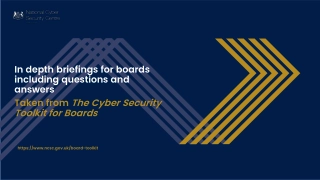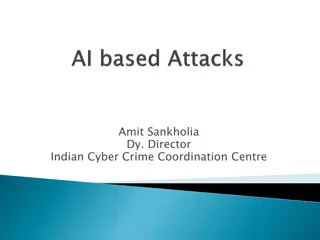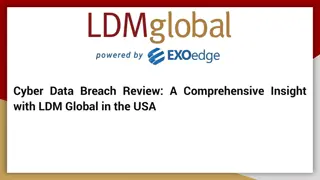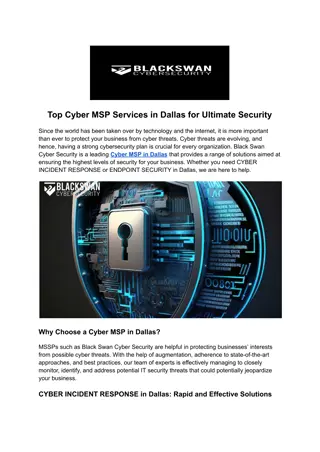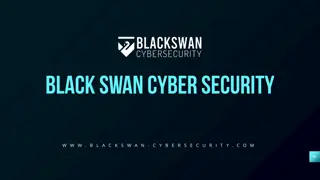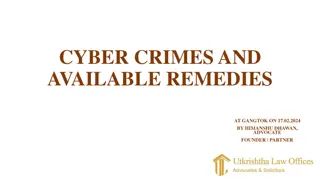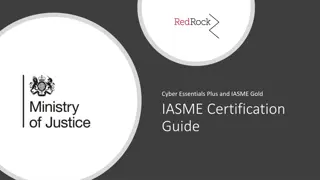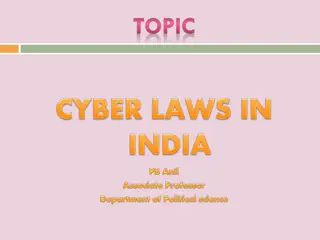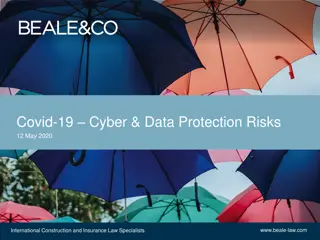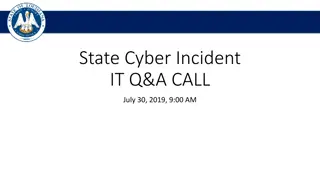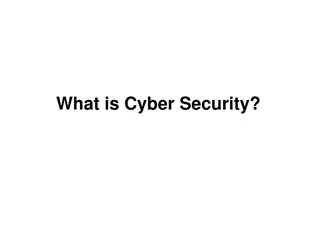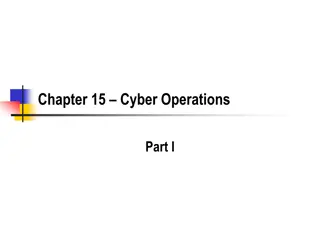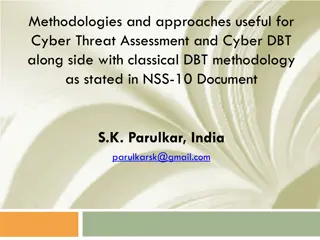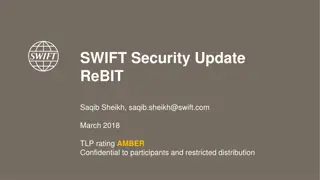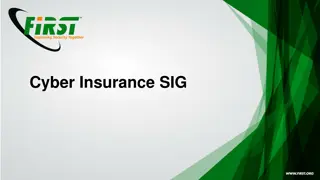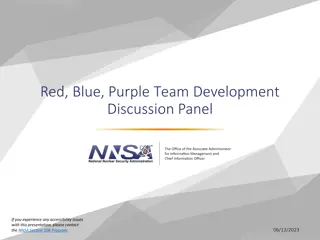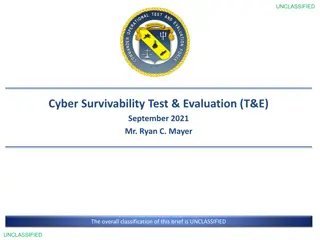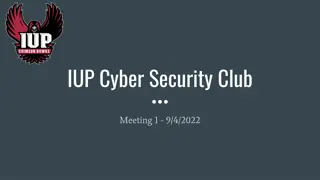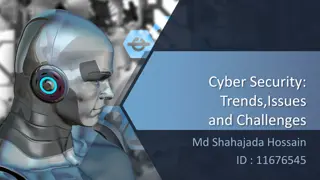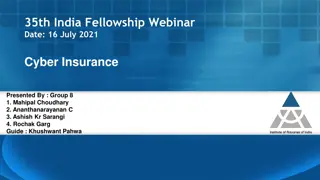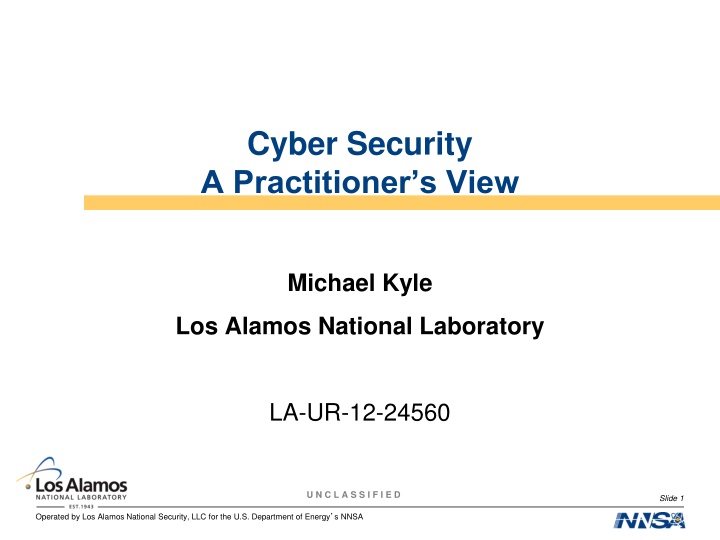
Cyber Security Practitioner's Insight at Los Alamos National Laboratory
Explore the mission, structure, skills, and tools of a cybersecurity practitioner, supporting organizational resilience and incident response. Learn about the standing CSIRT, skills required, and methodologies employed in the war room for effective cyber defense.
Download Presentation

Please find below an Image/Link to download the presentation.
The content on the website is provided AS IS for your information and personal use only. It may not be sold, licensed, or shared on other websites without obtaining consent from the author. If you encounter any issues during the download, it is possible that the publisher has removed the file from their server.
You are allowed to download the files provided on this website for personal or commercial use, subject to the condition that they are used lawfully. All files are the property of their respective owners.
The content on the website is provided AS IS for your information and personal use only. It may not be sold, licensed, or shared on other websites without obtaining consent from the author.
E N D
Presentation Transcript
Cyber Security A Practitioner s View Michael Kyle Los Alamos National Laboratory LA-UR-12-24560 U N C L A S S I F I E D Slide 1 Operated by Los Alamos National Security, LLC for the U.S. Department of Energy s NNSA
Topics Mission Structure Skills Data Acquisition War Room Tenants Rudimentary Case Discussion U N C L A S S I F I E D Slide 2 Operated by Los Alamos National Security, LLC for the U.S. Department of Energy s NNSA
Mission Support the mission of the organization Nutshell (not a mission statement) Minimize likelihood that an event will affect the organization. Minimize the mission impact when an incident does occur. Maximize speed in which we return to normal operations. Learn from events in order to Reduce costs of managing an event Increase quality of response when an event occurs Improve our understanding of everything Help protect the broader complex, thus protecting ourselves. U N C L A S S I F I E D Slide 3 Operated by Los Alamos National Security, LLC for the U.S. Department of Energy s NNSA
Structure: A Standing CSIRT CISO Line Mgmt CSIRT Team Leader Experienced Analysts Enterprise Forensics RE, Packet Analysts,... Specialists SOC/OPS Help Desk Tier 1/2 Analysts U N C L A S S I F I E D Slide 4 Operated by Los Alamos National Security, LLC for the U.S. Department of Energy s NNSA
Skills T1 Help Desk/Customer Service T2 General Analyst, searching for known bad data, responding to routine events, routine intel ingest (Open Source, DHS, AV companies, etc.), tuning IDS alerts, writing log rules and IOCs, T3 --- What they really do: Malware Analyzers Reverse Engineers Network Packet Analysts++ Enterprise Forensics engineers Programmers Preferably high-end system or network administration experience, too. Intelligence Collectors Human modeling U N C L A S S I F I E D Slide 5 Operated by Los Alamos National Security, LLC for the U.S. Department of Energy s NNSA
Tools and Data Acquisition Log Aggregation Indexed Rapid searching [Think forensics you re already compromised] Rule writing Statistical Analysis/Profiling [e.g., login->drive share mapping-> ] Tap Aggregation Flow Generation and Capture Network Behavioral Analysis Full PCAP where possible Indexed, . Enterprise and Live Response Forensics Enterprise IR Others U N C L A S S I F I E D Slide 6 Operated by Los Alamos National Security, LLC for the U.S. Department of Energy s NNSA
A War Room Methodology Virtual Servers Preconfigured Windows IR images Preconfigured Unix IR images Zero Client Server(s) Zero Clients IR Kit contains all pieces required to set rapidly set up war room Tested (very important) U N C L A S S I F I E D Slide 7 Operated by Los Alamos National Security, LLC for the U.S. Department of Energy s NNSA
Tenets You cannot defend every crack It is still prudent to defend You will be successfully attacked What are you going to do when it happens You may already have been successfully attacked (and not know it) U N C L A S S I F I E D Slide 8 Operated by Los Alamos National Security, LLC for the U.S. Department of Energy s NNSA
Targeted Email Phish CASE STUDY (SORT OF) U N C L A S S I F I E D Slide 9 Operated by Los Alamos National Security, LLC for the U.S. Department of Energy s NNSA
The Initial Vector Believable phish No sensors detect it as malicious Several people receive it (<1%) 10-15% click Rudimentary Risk Attack Trees can be inadequate. 70% have the target OS/Configuration (0.01)(0.10)(.07)=0.0007 Sidebar: Risk is low ? Is it OK to ignore this attack? If 0% of hosts have the target OS/Config then: Ignore this? U N C L A S S I F I E D Slide 10 Operated by Los Alamos National Security, LLC for the U.S. Department of Energy s NNSA
Typical Defense IPS IDS Mail Gateway Reputation AV Internal Mail Server AV Desktop AV U N C L A S S I F I E D Slide 11 Operated by Los Alamos National Security, LLC for the U.S. Department of Energy s NNSA
Advanced Defense IPS IDS Mail Gateway Reputation AV Automated Malware Sandbox(es) Internal Mail Server AV Desktop AV/Endpoint protection suite U N C L A S S I F I E D Slide 12 Operated by Los Alamos National Security, LLC for the U.S. Department of Energy s NNSA
Really Advanced Defense IPS IDS Mail Gateway Reputation AV Malware Sandbox Internal Mail Server AV Desktop AV/Endpoint protection Network Behavioral Analysis Log Statistical Analysis (frequencies, Markov Models, ) U N C L A S S I F I E D Slide 13 Operated by Los Alamos National Security, LLC for the U.S. Department of Energy s NNSA
The Malware Delivered Is it: Generic virus Botnet C2 Downloader Worm Combination Do we know who delivered it? Script kiddie, Hactivist, Organized Crime, Other Could there be other delivery mechanisms in play? Could this be a feint or other subterfuge? U N C L A S S I F I E D Slide 14 Operated by Los Alamos National Security, LLC for the U.S. Department of Energy s NNSA
On Statistical Detection Research to find known bad activity works great At finding the bad activity sample around which the model was designed. Now expand the window to unknown time windows Does it enable T1 to do more or better work in less time? False positives Small ingest teams can be easily overwhelmed 3% of 100,000 events is still too many taken by itself False negatives will always exist Response plans are a requirement Near instantaneous risk based decision making would be advantageous U N C L A S S I F I E D Slide 15 Operated by Los Alamos National Security, LLC for the U.S. Department of Energy s NNSA
Response Instantaneous decisions What do I know Where are the beachheads? How long? What lateral motion has taken place? What data is at risk from the hosts, shares or other trust relationships? What data is at risk from the credentials on each host? What credentials are in memory on the hosts? What lateral motion is possible given that information? What C2 is occurring from how many locations? What exfiltration is occurring? What destinations? Are other attacks occurring? U N C L A S S I F I E D Slide 16 Operated by Los Alamos National Security, LLC for the U.S. Department of Energy s NNSA
Terminating an Event/Managing Our Risk If I counterstrike too early? Too late? How much do I need to know to actually terminate the risk from an event or limit the risk from a future event? Listen for how long? What is all of the command and control? Exfil points? What is being targeted? Where are they now in our network? Can we maintain control while monitoring or will we lose more? Can the event be shaped? redirect the attacker to less risky targets? Interfere with a portion of their communications? Shut down some hosts? What does the attacker learn from such actions? Strike we are on the defensive. Can we kill all internal beachheads? C2? Exfiltration? Can we stop other incursions? Do we know enough at this stage to succeed? U N C L A S S I F I E D Slide 17 Operated by Los Alamos National Security, LLC for the U.S. Department of Energy s NNSA
Mitigation Time Too early and we play whack-a- mole Strike Zone Too late and we lose the farm U N C L A S S I F I E D Slide 18 Operated by Los Alamos National Security, LLC for the U.S. Department of Energy s NNSA
Reiterating a prior slide Research to find known bad activity works great At finding the bad activity sample around which the model was designed. Now expand the window to unknown time windows False positives Small ingest teams can be easily overwhelmed 3% of 100,000 events is still too many taken by itself False negatives will always exist Response plans are a requirement Near instantaneous risk based decision making would be advantageous Guest Scientist Programs U N C L A S S I F I E D Slide 19 Operated by Los Alamos National Security, LLC for the U.S. Department of Energy s NNSA
Conclusions Plan for finite resources Low false positives Low false negatives Easy work prioritization Need to enhance a T1 or T2 ability (free time for T3) Need help making instantaneous risk based decisions (when to strike) Need to map credentials and hosts to data at risk Need to understand what is on the other end Automation, a human, etc Understand the difference between active attacks, multiple simultaneous attacks and long term persistence Think we are compromised how do we learn all we can while minimizing risk and how do we effectively and completely terminate the event? U N C L A S S I F I E D Slide 20 Operated by Los Alamos National Security, LLC for the U.S. Department of Energy s NNSA
Comments or Questions? Questions? U N C L A S S I F I E D Slide 21 Operated by Los Alamos National Security, LLC for the U.S. Department of Energy s NNSA


